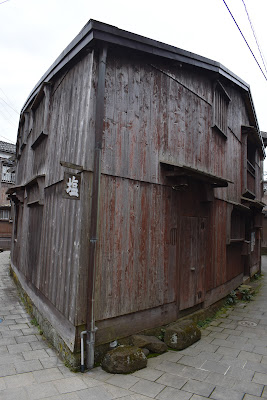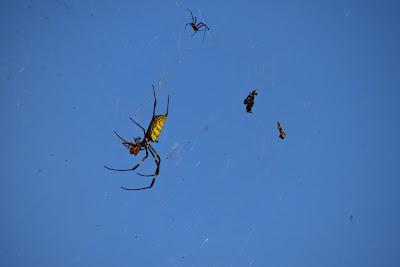Monday, April 22, 2024
Sado Trip: Ancient Rice Planting Ceremony
The text on the signboard explains the tradition, which is over 1000 years old. This video was produced by a local TV station.
Sado Trip: State of Abandon
I camped here 20 years ago when my eldest was six, the two of us riding the 30-odd kilometers from the ferry port, Ryotsu.
Sigh. It's been closed for some time now, clearly. Such sights (often referred to as 廃墟- haikyo, ruins) are common throughout Japan. Alas.
Sado Trip: Buoy Art Gallery
"Buoy Art" read the sign by the road. Was intrigued, so checked it out.
Unfortunately, if unsurprisingly, the Sado coastline is in places littered with bouys and other flotsam. I would have liked to meet the beachcomber and inspiration behind this strange installation.
Bamboo
With the ideogram for bamboo (竹) serving as the radical or base for 1181 characters, the importance of take to Japanese language and culture can be easily appreciated. Some examples:
箸:hashi- chopsticks
筆:fude, hitsu- brush (writing or painting), pen, writing implement.
When take is used in this way, it is placed above the other character(s) and is known as 竹冠- take-kanmuri, or bamboo crown.
Incidentally, kusa, or grass (草) tops this list at 2173, the crown above 早 serving as the radical.
Friday, April 19, 2024
Sado Photos- Shukunegi
Tuesday, April 16, 2024
Sado Photos: The Sotokaifu Coast
The seaward side of Sado is known as Sotokaifu, the coastline wilder and more rugged than Uchikaifu on the opposite side of the island.
Sado Photos: Kotohira Shrine
Kotohira Shrine (金刀比羅神社), Aikawa. As the photos and votive panels suggest, the shrine is dedicated to the well-being and prosperity of local mariners. No friendly felines (as at Seisui Temple), restoration long overdue, Kotohira was forlorn indeed.
Sado Photos: Seisui Temple
Tuesday, April 09, 2024
Sado Photos: Diving School
Because of its clear waters, Sado is a popular diving destination. Housed in a defunct primary school, the Kita Koura Diving Center's (itself defunct) signage shows a diver encountering a friendly-looking Asian Sheepshead wrasse, or kobudai コブダイ.
Sado Photos: Seaweed
Seaweed (wakame?) drying on the
sotokaifu 外海府seaward (as opposed to its opposite, the uchikaifu 内海府 mainland- facing ) coast of Sado.
Monday, April 08, 2024
Sado Photos: Tunnel Art
Many tunnels on Sado feature decorative panels. On the right: 鬼の田植, Demon Planting Rice; opposite: 甘草に変身した鯛(?), The Red Snapper That Turned into a Day Lily. The former refers to a Sado Island folktale, while the day lily, or kanzou, is prolific at the northern tip of Sado in the vicinity of Futatsugame and Onogame.
Sado Island Photos: Taraibune
Photos (video here and here) from a recent trip to Sado Island.
Taraibue, or tub boats, were traditionally used to fish for shellfish in the shallow waters off Ogi and Shukunegi. My taraibune captain narrated the history of Shukunegi, hamlet and harbor, explaining that a powerful earthquake some 200 years ago caused uplift of 2 meters, curtailing the use of the latter by trading vessels- called kitamaebune (北前船)- sailing between Hokkaido and Osaka. Neighboring Ogi, with its deeper harbor, was able to accomodate the ships, while Shukunegi retained its status as home to maritime aristocracy: shipwrights, carpenters, and captains. Incidentally, the steerer of the taraibune built the boat himself and even paddled it once the 70-odd kilometers to the mainland.
Friday, March 29, 2024
高半(Takahan), Yuzawa, Setting for Kawabata Yasunari's "Snow Country" (雪国)
Takahan, the ryokan in Yuzawa, Niigata, where Kawabata wrote the novel 雪国, whose famous opening line reads: 国境の長いトンネルを抜けると雪国であった (The train came out of the long tunnel into the snow country).
Subscribe to:
Posts (Atom)






















































